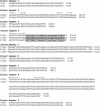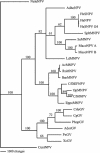Sequence and organization of the Neodiprion lecontei nucleopolyhedrovirus genome
- PMID: 15194779
- PMCID: PMC421645
- DOI: 10.1128/JVI.78.13.7023-7035.2004
Sequence and organization of the Neodiprion lecontei nucleopolyhedrovirus genome
Abstract
All fully sequenced baculovirus genomes, with the exception of the dipteran Culex nigripalpus nucleopolyhedrovirus (CuniNPV), have previously been from Lepidoptera. This study reports the sequencing and characterization of a hymenopteran baculovirus, Neodiprion lecontei nucleopolyhedrovirus (NeleNPV), from the redheaded pine sawfly. NeleNPV has the smallest genome so far published (81,755 bp) and has a GC content of only 33.3%. It contains 89 potential open reading frames, 43 with baculovirus homologues, 6 identified by conserved domains, and 1 with homology to a densovirus structural protein. Average amino acid identity of homologues ranged from 19.7% with CuniNPV to 24.9% with Spodoptera exigua nucleopolyhedrovirus. The conserved set of baculovirus genes has dropped to 29, since NeleNPV lacks an F protein homologue (ac23/ld130). NeleNPV contains 12 conserved lepidopteran baculovirus genes, including that for DNA binding protein, late expression factor 11 (lef-11), polyhedrin, occlusion derived virus envelope protein-18 (odv-e18), p40, and p45, but lacks 21 others, including lef-3, me53, immediate early gene-1, lef-6, pp31, odv-e66, few polyhedra 25k, odv-e25, protein kinase-1, fibroblast growth factor, and ubiquitin. The lack of identified baculovirus homologues may be due to difficulties in identification, differences in host-virus interactions, or other genes performing similar functions. Gene parity plots showed limited colinearity of NeleNPV with other baculoviruses, and phylogenetic analysis indicates that NeleNPV may have existed before the lepidopteran nucleopolyhedrovirus and granulovirus divergence. The creation of two new Baculoviridae genera to fit hymenopteran and dipteran baculoviruses may be necessary.
Figures




Similar articles
-
Genome sequence of a baculovirus pathogenic for Culex nigripalpus.J Virol. 2001 Nov;75(22):11157-65. doi: 10.1128/JVI.75.22.11157-11165.2001. J Virol. 2001. PMID: 11602755 Free PMC article.
-
Genomic comparison of Neodiprion sertifer and Neodiprion lecontei nucleopolyhedroviruses and identification of potential hymenopteran baculovirus-specific open reading frames.J Gen Virol. 2006 Jun;87(Pt 6):1477-1489. doi: 10.1099/vir.0.81727-0. J Gen Virol. 2006. PMID: 16690912
-
Sequence analysis and organization of the Neodiprion abietis nucleopolyhedrovirus genome.J Virol. 2006 Jul;80(14):6952-63. doi: 10.1128/JVI.00187-06. J Virol. 2006. PMID: 16809301 Free PMC article.
-
The genome sequence and evolution of baculoviruses.Annu Rev Entomol. 2003;48:211-34. doi: 10.1146/annurev.ento.48.091801.112756. Epub 2001 Sep 28. Annu Rev Entomol. 2003. PMID: 12414741 Review.
-
Baculovirus genomics.Curr Drug Targets. 2007 Oct;8(10):1051-68. doi: 10.2174/138945007782151333. Curr Drug Targets. 2007. PMID: 17979665 Review.
Cited by
-
A cellular Drosophila melanogaster protein with similarity to baculovirus F envelope fusion proteins.J Virol. 2005 Jul;79(13):7979-89. doi: 10.1128/JVI.79.13.7979-7989.2005. J Virol. 2005. PMID: 15956544 Free PMC article.
-
vlf-1 deletion brought AcMNPV to defect in nucleocapsid formation.Virus Genes. 2005 Dec;31(3):275-84. doi: 10.1007/s11262-005-3242-3. Virus Genes. 2005. PMID: 16175333
-
The History of Baculovirology in Africa.Viruses. 2023 Jul 7;15(7):1519. doi: 10.3390/v15071519. Viruses. 2023. PMID: 37515205 Free PMC article. Review.
-
The Autographa californica Multiple Nucleopolyhedrovirus ac54 Gene Is Crucial for Localization of the Major Capsid Protein VP39 at the Site of Nucleocapsid Assembly.J Virol. 2016 Mar 28;90(8):4115-4126. doi: 10.1128/JVI.02885-15. Print 2016 Apr. J Virol. 2016. PMID: 26865720 Free PMC article.
-
Comparative genomics of the Neodiprion sertifer nucleopolyhedrovirus from Turkey with the fewest ORFs among baculoviruses.Virus Genes. 2024 Apr;60(2):194-207. doi: 10.1007/s11262-024-02050-1. Epub 2024 Jan 19. Virus Genes. 2024. PMID: 38240955
References
-
- Ahrens, C. H., R. L. Q. Russell, C. J. Funk, J. T. Evans, S. H. Harwood, and G. F. Rohrmann. 1997. The sequence of the Orgyia pseudotsugata multinucleocapsid nuclear polyhedrosis virus genome. Virology 229:381-399. - PubMed
-
- Altschul, S. F., W. Gish, W. Miller, E. W. Myers, and D. J. Lipman. 1990. Basic local alignment search tool. J. Mol. Biol. 215:403-410. - PubMed
Publication types
MeSH terms
Substances
Associated data
- Actions
LinkOut - more resources
Full Text Sources
Miscellaneous

